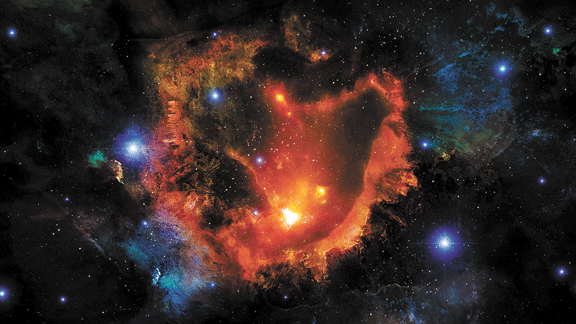Our place in the cosmos

More than 500 million people have watched Carl Sagan’s brilliant 1980 TV series Cosmos: a personal voyage and its repeats. The follow-up, Cosmos: a spacetime odyssey, hosted by astrophysicist Neil deGrasse Tyson, draws on three decades of new discoveries and a slick new CGI spaceship.
Cosmos explores humanity’s history of imagining and investigating our place among the stars – from hunter-gatherer societies through Copernicus’ heliocentrism, Bruno’s first notion of a universe to the discoveries of today and the possibilities for the future.
The program dares us to wonder about the biological basis for life on other planets, or the possibility of future human societies on planets other than Earth. Viewing the universe from this perspective implicitly calls into question the pettiness that divides and holds back humanity – the wars, the national borders and the competition for profit that risks the future of our planet.
Cosmos traces the evolution of life from its earliest days in what Darwin called “warm pools” through 3.6 billion years of environmental and behavioural pressures that selected some random genetic mutations over others. The similarities in the genetic code between a tree and a human serve as a remarkable illustration of the connectedness of all life. But Cosmos extends our connection to the entire universe. In Sagan’s words, “We are all made of star stuff.”
In this way, Cosmos situates humans within nature, but also separated from it due to a mastery of our environment. The latter is not simply biological, but social. Social organisation allows us to rise above the tasks required for survival and look to the stars. As Sagan said, “We are a way for the universe to know itself.”
Cosmos moves seamlessly from astrophysics to evolution, from the beginning of time to the future. On its way, it dissolves the boundaries between scientific disciplines. This is a totality on the most magnificent scale. One is left with a profound sense of connection to all our fellow species and with the history and future of far distant galaxies.
That is no easy task, but Tyson and his scriptwriters stand on the shoulders of a giant of astrophysics. Carl Sagan (1934-1996) was professor of astronomy at Cornell University, a brilliant cosmologist who authored more than 600 academic papers and advised on NASA missions to Venus, Mars and Jupiter.
Sagan was not afraid to mix science and politics. He resigned from the scientific advisory body of the US air force in protest over the Vietnam War, publicly opposed the Star Wars program, and was arrested twice while protesting against US nuclear testing.
Sagan used science as activism to campaign against the nuclear arms race. He hypothesised the catastrophic consequences of nuclear war in which firestorms, smoke and dust suspended in the upper stratosphere would block the sun, radically dropping the earth’s surface temperature to Ice Age levels for years to come.
This dark vision led Sagan to moderate his expectation of encountering intelligent extraterrestrial life. He saw the destruction of civilisation through war as a real prospect, and not just on Earth. Sagan and other astronomers factored this limitation into predictions of the number of advanced extraterrestrial civilisations inhabiting our galaxy using the final term in the Drake equation.
This term accounts for the fraction of a habitable planet’s lifetime in which it is populated by a technological civilisation, before that society succumbs to “the trap set jointly by their technology and their passions”. Sagan expounded the tragedy of civilisations that might “take billions of years of tortuous evolution to arise and then snuff themselves out in an instant of unforgivable neglect”. Yet he had hope that advanced societies might survive their “technological adolescence” and avoid self-destruction.
Sagan was a materialist and a believer in human reason and progress. Although not a Marxist, he admired Leon Trotsky and confessed to routinely smuggling copies of his History of the Russian Revolution into the USSR.
Even the greatest minds are limited by the age in which they live. It can be easier to imagine space travel through worm holes or the stretching of space-time than to imagine the kind of human society necessary to give rise to a determined exploration of the universe.
Our economic and political system is holding back development through vested interests and destruction through war and economic crises. The competition between rival capitalists has held back the technological advancements that could aid humanity and our planet.
Sometimes it is done consciously – such as with renewable energy expansion, the delay of which profits the fossil fuel industry. Each time a beneficial yet unprofitable development is held back from greater use, it delays further technological advances that would have stood on its shoulders.
To mobilise the energy of humanity and the resources of our planet for the journey to the stars will take an effort unheard of in all of history. The preconditions for such a leap are not just technological, but social. If humanity cannot provide for its existence on this planet, how can we prepare for anything greater? It is unlikely that we will be able to reach for the stars without a collectively run society in which humans can truly master our own planet’s resources.